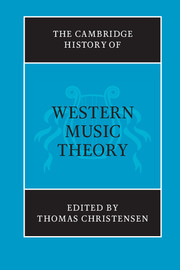Book contents
- Frontmatter
- Introduction
- PART I DISCIPLINING MUSIC THEORY
- PART II SPECULATIVE TRADITIONS
- PART III REGULATIVE TRADITIONS
- A Mapping tonal spaces
- B Compositional Theory
- 15 Organum – discantus – contrapunctus in the Middle Ages
- 16 Counterpoint pedagogy in the Renaissance
- 17 Performance theory
- 18 Steps to Parnassus: contrapuntal theory in 1725 precursors and successors
- 19 Twelve-tone theory
- C Time
- D Tonality
- PART IV DESCRIPTIVE TRADITIONS
- Index of authors
- Index of subjects
- References
18 - Steps to Parnassus: contrapuntal theory in 1725 precursors and successors
from B - Compositional Theory
Published online by Cambridge University Press: 28 March 2008
- Frontmatter
- Introduction
- PART I DISCIPLINING MUSIC THEORY
- PART II SPECULATIVE TRADITIONS
- PART III REGULATIVE TRADITIONS
- A Mapping tonal spaces
- B Compositional Theory
- 15 Organum – discantus – contrapunctus in the Middle Ages
- 16 Counterpoint pedagogy in the Renaissance
- 17 Performance theory
- 18 Steps to Parnassus: contrapuntal theory in 1725 precursors and successors
- 19 Twelve-tone theory
- C Time
- D Tonality
- PART IV DESCRIPTIVE TRADITIONS
- Index of authors
- Index of subjects
- References
Summary
For 250 years, the Gradus ad Parnassum of Johann Joseph Fox (1660–1741) has been a tabula by-no-means rasa on which theorists and pedagogues have written. The remarkable process of accretion and rewriting began within seventeen years of its initial publication, with its first translation – ironically into Fux’s own language, German – in 1742. There is no denying that Fux himself had drawn on theorists’ writings going back 200 years, indeed back to the Greeks; but the result was no derivative hodgepodge. For all its borrowing and recasting – mostly unacknowledged, in the twentieth-century, positivistic sense – it possesses a sharpness of focus and a singleness of purpose that remain perhaps unrivaled.
“Manuductio ad”…: Virgilian footsteps
The work’s title begins:
Steps to Parnassus; or, Guide to Musical Composition by the Rules, using a New and Sure Method, never before published in so Methodical an Arrangement
This title plays in complex ways with the reader’s expectations. According to the subtitle, it is a manuductio – a “leading by the hand.” Like many other treatises before it – for example, Samber’s Manuductio organica (Manuductio to the Organ; that is, Thorough and Sure Guide) (1704), and Niedt’s Musicalische Handleitung (1700–17) – it offers a certain reassurance that the reader will not be left unaided. As a -ductio, the Gradus distinguishes itself from theoretical works with such appellations as “Treatise,” “Method,” “System,” “Summa,” and “Compendium,” all of which offer a formalized statement of a theory or collection of theories. Moreover, it is not merely an intro-duction, but a manu-duction, recalling Virgil’s guidance of Dante through the Inferno and Purgatory (“He laid his hand on mine, and with a face / So joyous that it comforted my quailing, / Into the hidden things he led my ways”).
- Type
- Chapter
- Information
- The Cambridge History of Western Music Theory , pp. 554 - 602Publisher: Cambridge University PressPrint publication year: 2002
References
- 4
- Cited by

